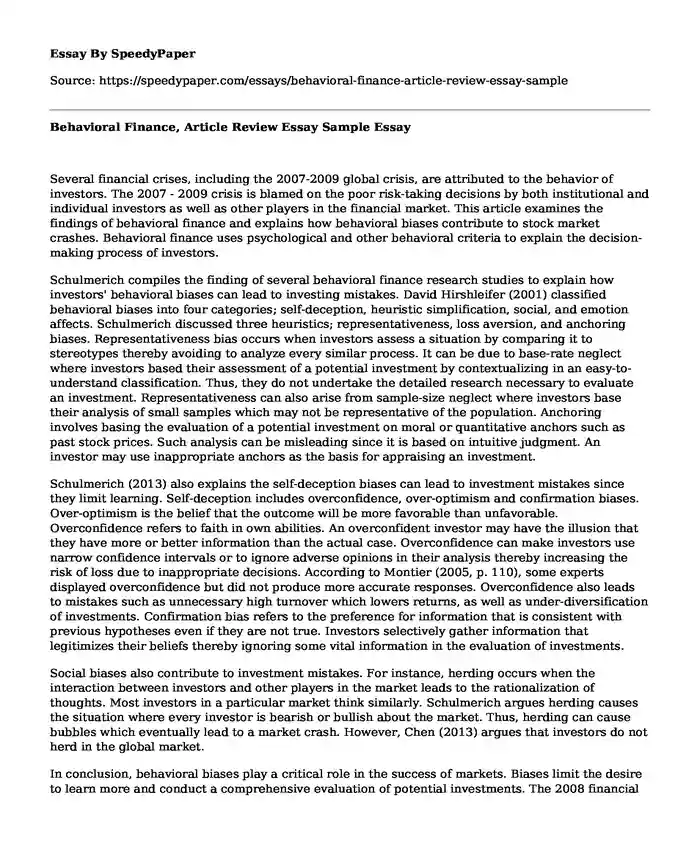Several financial crises, including the 2007-2009 global crisis, are attributed to the behavior of investors. The 2007 - 2009 crisis is blamed on the poor risk-taking decisions by both institutional and individual investors as well as other players in the financial market. This article examines the findings of behavioral finance and explains how behavioral biases contribute to stock market crashes. Behavioral finance uses psychological and other behavioral criteria to explain the decision-making process of investors.
Schulmerich compiles the finding of several behavioral finance research studies to explain how investors' behavioral biases can lead to investing mistakes. David Hirshleifer (2001) classified behavioral biases into four categories; self-deception, heuristic simplification, social, and emotion affects. Schulmerich discussed three heuristics; representativeness, loss aversion, and anchoring biases. Representativeness bias occurs when investors assess a situation by comparing it to stereotypes thereby avoiding to analyze every similar process. It can be due to base-rate neglect where investors based their assessment of a potential investment by contextualizing in an easy-to-understand classification. Thus, they do not undertake the detailed research necessary to evaluate an investment. Representativeness can also arise from sample-size neglect where investors base their analysis of small samples which may not be representative of the population. Anchoring involves basing the evaluation of a potential investment on moral or quantitative anchors such as past stock prices. Such analysis can be misleading since it is based on intuitive judgment. An investor may use inappropriate anchors as the basis for appraising an investment.
Schulmerich (2013) also explains the self-deception biases can lead to investment mistakes since they limit learning. Self-deception includes overconfidence, over-optimism and confirmation biases. Over-optimism is the belief that the outcome will be more favorable than unfavorable. Overconfidence refers to faith in own abilities. An overconfident investor may have the illusion that they have more or better information than the actual case. Overconfidence can make investors use narrow confidence intervals or to ignore adverse opinions in their analysis thereby increasing the risk of loss due to inappropriate decisions. According to Montier (2005, p. 110), some experts displayed overconfidence but did not produce more accurate responses. Overconfidence also leads to mistakes such as unnecessary high turnover which lowers returns, as well as under-diversification of investments. Confirmation bias refers to the preference for information that is consistent with previous hypotheses even if they are not true. Investors selectively gather information that legitimizes their beliefs thereby ignoring some vital information in the evaluation of investments.
Social biases also contribute to investment mistakes. For instance, herding occurs when the interaction between investors and other players in the market leads to the rationalization of thoughts. Most investors in a particular market think similarly. Schulmerich argues herding causes the situation where every investor is bearish or bullish about the market. Thus, herding can cause bubbles which eventually lead to a market crash. However, Chen (2013) argues that investors do not herd in the global market.
In conclusion, behavioral biases play a critical role in the success of markets. Biases limit the desire to learn more and conduct a comprehensive evaluation of potential investments. The 2008 financial crisis is an illustration of biases such as herding, overconfidence, among others. Many investors invested in the toxic subprime mortgages and did not conduct a proper evaluation of the risk associated with the investments. The aggregate effect of the individual investor biases can lead to the collapse of the market as was in 2007 and other financial crises.
References
Chen, T. (2013). Do Investors Herd in Global Stock Markets?. Journal Of Behavioral Finance, 14(3), 230-239. doi: 10.1080/15427560.2013.819804
Hirshleifer, D. (2001). Investor Psychology and Asset Pricing. SSRN Electronic Journal. doi: 10.2139/ssrn.265132
Montier, J. (2005). Seven Sins of Fund Management. SSRN Electronic Journal. doi: 10.2139/ssrn.881760
Schulmerich, M. (2014). Behavioral Finance in Asset Management: A Primer. Investments & Wealth Monitor, 42-47.
Cite this page
Behavioral Finance, Article Review Essay Sample. (2022, Jul 13). Retrieved from https://speedypaper.com/essays/behavioral-finance-article-review-essay-sample
Request Removal
If you are the original author of this essay and no longer wish to have it published on the SpeedyPaper website, please click below to request its removal:
- How To Improve Writing Skill Essay Sample
- Literary Essay Sample: The Use of Setting and Atmosphere in Dracula by B. Stoker
- Landlord Tenant Law - Learn More from Our Free Essay
- Essay Sample Dedicated to Nuclear Weapons Possession Rights
- Essay Example in History: Revolution in China
- Essay Sample: Obesity Trends in the United States
- Essay Sample on The Facade of the American Dream
Popular categories





